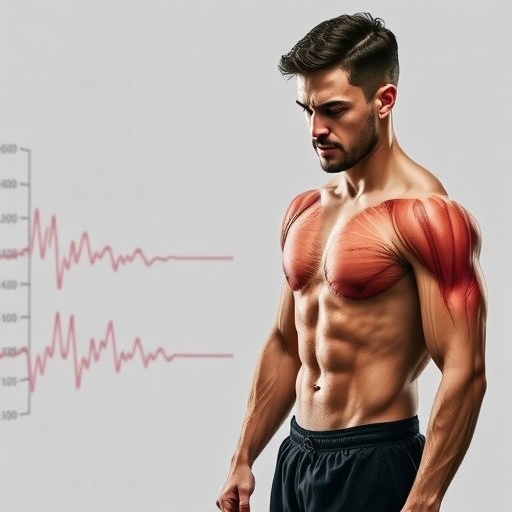In a groundbreaking study published in Scientific Reports, researchers Nofal, Kois, Elbasty, and colleagues undertake a thorough examination of muscle activities during different methods of locating centric relation in the jaw. This research, set within the emerging field of dental and orthodontic studies, aims to enhance our understanding of how these methods may influence the anterior temporalis and masseter muscles. Such muscle activation is a critical aspect of dental interventions and could significantly impact patient comfort and treatment efficacy.
The study highlights the various methodologies employed to find centric relation, which is the maxillomandibular relationship when the condyles are in their anterior-superior position in the glenoid fossae. This relationship is pivotal in dentistry, as it serves as a reference point for occlusion and is crucial for restorative and orthodontic procedures. For many clinicians, understanding the muscular implications of these methods helps in tailoring treatments to the individual needs of patients.
Conducted as a randomized cross-over trial, the research involved different centric relation locating techniques, allowing participants to serve as their own controls. This design not only enhances the reliability of the results but also underscores the significance of patient responses to varied methodologies. Participants’ muscle activities were meticulously recorded, gauging the anterior temporalis and masseter muscle activations that occurred during each trial.
The diverse methodologies assessed in the study included traditional manual and digital methods. Manual methods, often reliant on the clinician’s subjective interpretation and palpation, contrast sharply with digital approaches that utilize advanced imaging and software technology. The study meticulously accounts for changes in muscle activity resulting from the variation in locating techniques, thereby uncovering subtle but important differences that could inform best practices within dental settings.
One compelling finding of the research is the difference in muscle activation patterns between these various techniques. The anterior temporalis, known for its role in elevating the mandible, showed distinct variations in activity levels which correlated with the centric relation locating method employed. Similarly, the masseter muscle, one of the primary muscles involved in chewing, exhibited fluctuations in electrical activity. Understanding these patterns could illuminate the physiological implications of centric relation methods on muscle fatigue and discomfort.
Furthermore, the study delves into the significance of these findings in relation to patient-centered care. In dentistry, where a thorough understanding of occlusion is paramount, such insights could lead to improved comfort levels during procedures, potentially reducing recovery time and increasing overall satisfaction with dental treatments. The optimization of dental practices based on empirical evidence could bolster the reputation of clinicians and enhance patient outcomes.
Another noteworthy aspect of the research lies in its implications for future studies. By establishing a robust set of data regarding muscle activity in association with centric relation methods, this trial lays the groundwork for subsequent research aimed at refining these techniques further. Investigating the relationship between muscle fatigue, pain levels, and particular methods could yield valuable insights that move the dental field forward.
Moreover, the trial emphasizes the need for standardization in techniques used to locate centric relation. By highlighting the discrepancies in muscle activation throughout the different methodologies, dental professionals are called to reflect on their current practices. Standardizing techniques based on empirical data could significantly reduce variability in patient care outcomes, ultimately contributing to a higher standard of dental treatment.
Considerable attention is also given to the technological advancements that are shaping the dental landscape. The inclusion of digital methods of centric relation locating speaks to a broader trend of integrating technology into healthcare. The efficacy of these technologies raises questions about the future of clinical practice and how they can be adopted across various settings to ensure that patients receive the best possible care.
In summary, the study conducted by Nofal, Kois, Elbasty, and colleagues presents crucial evidence regarding anterior temporalis and masseter muscle activity in relation to different centric relation locating methods in the dental field. By drawing direct correlations between methodology and muscle activation, the authors have opened a new realm of understanding that not only has the potential to improve clinical outcomes but could also reshape conventional practices.
In addition, this pioneering research illustrates the importance of continuous inquiry and advancement in the field of dentistry. As technology and methodologies evolve, so too must our understanding of their effects on human physiology and patient care. Consequently, such studies provide a strong imperative for clinicians to remain engaged with the latest research findings and integrate them into their practices to enhance patient outcomes.
The implications of this study extend beyond mere clinical practice; they also encourage further research into the intricate relationships between jaw positioning, muscle activity, and overall oral health. By adopting a scientific lens to these common dental challenges, researchers and practitioners alike can foster innovative solutions that directly improve the quality of care provided to patients.
In conclusion, this significant research offers a fresh perspective on an often-overlooked aspect of dentistry. By correlating centric relation locating methods with muscle activity, researchers are laying the groundwork for improvements that could ultimately transform patient experiences and outcomes in dental care. As practitioners become acquainted with these findings, the potential for enhanced patient-centric practices becomes more tangible, ushering in a new era of informed dentistry grounded in rigorous scientific inquiry.
Subject of Research: Muscle activity in different centric relation locating methods.
Article Title: Anterior temporalis and masseter muscle activity with different centric relation locating methods: A randomized cross-over trial.
Article References: Nofal, A.T., Kois, J.C., Elbasty, R.S. et al. Anterior temporalis and masseter muscle activity with different centric relation locating methods: A randomized cross-over trial. Sci Rep 15, 35568 (2025). https://doi.org/10.1038/s41598-025-21616-z
Image Credits: AI Generated
DOI:
Keywords: Muscle activity, centric relation, temporalis, masseter, dental methods, randomized trial.
Tags: centric relation locating techniquesdental intervention efficacyinfluence of centric relation on dental treatmentsmasseter muscle activationmaxillomandibular relationship importancemethodologies in dental studiesmuscle activation assessment in orthodonticsmuscle activity in dentistryorthodontic treatment methodspatient comfort in dental proceduresrandomized cross-over trial in dentistrytemporalis muscle function





